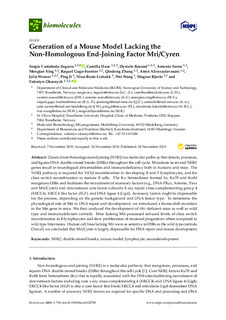| dc.contributor.author | Castaneda Zegarra, Sergio Miguel | |
| dc.contributor.author | Huse, Camilla | |
| dc.contributor.author | Røsand, Øystein | |
| dc.contributor.author | Sarno, Antonio | |
| dc.contributor.author | Xing, Mengtan | |
| dc.contributor.author | Zhang, Qindong | |
| dc.contributor.author | Alirezaylavasani, Amin | |
| dc.contributor.author | Werner, Julia | |
| dc.contributor.author | Ji, Ping | |
| dc.contributor.author | Liabakk, Nina-Beate | |
| dc.contributor.author | Wang, Wei | |
| dc.contributor.author | Bjørås, Magnar | |
| dc.contributor.author | Oksenych, Valentyn | |
| dc.date.accessioned | 2020-01-15T13:06:21Z | |
| dc.date.available | 2020-01-15T13:06:21Z | |
| dc.date.created | 2019-12-19T10:53:29Z | |
| dc.date.issued | 2019 | |
| dc.identifier.issn | 2218-273X | |
| dc.identifier.uri | http://hdl.handle.net/11250/2636442 | |
| dc.description.abstract | Classical non-homologous end joining (NHEJ) is a molecular pathway that detects, processes, and ligates DNA double-strand breaks (DSBs) throughout the cell cycle. Mutations in several NHEJ genes result in neurological abnormalities and immunodeficiency both in humans and mice. The NHEJ pathway is required for V(D)J recombination in developing B and T lymphocytes, and for class switch recombination in mature B cells. The Ku heterodimer formed by Ku70 and Ku80 recognizes DSBs and facilitates the recruitment of accessory factors (e.g., DNA-PKcs, Artemis, Paxx and Mri/Cyren) and downstream core factor subunits X-ray repair cross-complementing group 4 (XRCC4), XRCC4-like factor (XLF), and DNA ligase 4 (Lig4). Accessory factors might be dispensable for the process, depending on the genetic background and DNA lesion type. To determine the physiological role of Mri in DNA repair and development, we introduced a frame-shift mutation in the Mri gene in mice. We then analyzed the development of Mri-deficient mice as well as wild type and immunodeficient controls. Mice lacking Mri possessed reduced levels of class switch recombination in B lymphocytes and slow proliferation of neuronal progenitors when compared to wild type littermates. Human cell lines lacking Mri were as sensitive to DSBs as the wild type controls. Overall, we concluded that Mri/Cyren is largely dispensable for DNA repair and mouse development. | nb_NO |
| dc.description.abstract | Generation of a Mouse Model Lacking the Non-Homologous End-Joining Factor Mri/Cyren | nb_NO |
| dc.language.iso | eng | nb_NO |
| dc.publisher | MDPI | nb_NO |
| dc.rights | Navngivelse 4.0 Internasjonal | * |
| dc.rights.uri | http://creativecommons.org/licenses/by/4.0/deed.no | * |
| dc.title | Generation of a Mouse Model Lacking the Non-Homologous End-Joining Factor Mri/Cyren | nb_NO |
| dc.type | Journal article | nb_NO |
| dc.type | Peer reviewed | nb_NO |
| dc.description.version | publishedVersion | nb_NO |
| dc.source.volume | 9 | nb_NO |
| dc.source.journal | Biomolecules | nb_NO |
| dc.source.issue | 12 | nb_NO |
| dc.identifier.doi | 10.3390/biom9120798 | |
| dc.identifier.cristin | 1762883 | |
| dc.relation.project | Norges forskningsråd: 249774 | nb_NO |
| dc.relation.project | Kreftforeningen: 182355 | nb_NO |
| dc.relation.project | Samarbeidsorganet mellom Helse Midt-Norge og NTNU: 13477 | nb_NO |
| dc.description.localcode | © 2019 by the authors. Licensee MDPI, Basel, Switzerland. This article is an open access article distributed under the terms and conditions of the Creative Commons Attribution (CC BY) license (http://creativecommons.org/licenses/by/4.0/). | nb_NO |
| cristin.unitcode | 194,65,15,0 | |
| cristin.unitcode | 194,14,30,0 | |
| cristin.unitcode | 1920,15,0,0 | |
| cristin.unitname | Institutt for klinisk og molekylær medisin | |
| cristin.unitname | NTNU Universitetsbiblioteket | |
| cristin.unitname | Medisinsk klinikk | |
| cristin.ispublished | true | |
| cristin.fulltext | original | |
| cristin.qualitycode | 1 | |

